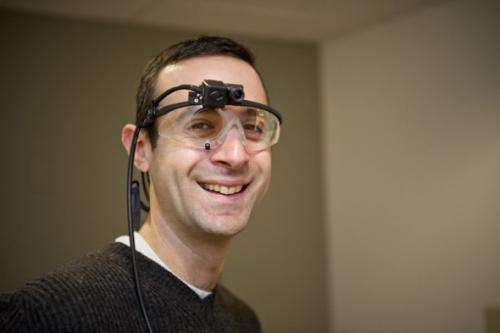In a bad mood? Change the channel

If a war scene, horror flick, or some other negative image appears on the television, older adults will tend to avert their eyes.
Derek Isaacowitz, associate professor in the College of Science's Department of Psychology, has studied this behavior for several years using eye-tracking technology in a novel way to pinpoint exactly what a person is fixing his or her attention on and for how long. In the case of older adults, the results so far have revealed a pattern of viewing focused on positive stimuli that may serve emotion regulation—and may partially explain the higher levels of happiness that are also recorded among older adults.
But the current research setting is a bit too contrived, Isaacowitz said, and it may not be the best way to test the question of how older and younger adults differ in their strategies to control their emotions.
"In our everyday lives, when we're regulating our emotion, it's rarely the case that somebody forces you to look at something," he said. "We exert control over what we are exposed to, and that may be a really critical way that we regulate our emotion."
For instance, instead of simply looking away from the TV or computer screen, one could change the channel or navigate to a new Web page. In order to get around this, he has recently begun to simulate the real world experience in the lab by offering participants a variety of media to choose from, including multiple screens and websites.
"But there's a big technological problem here," Isaacowitz explained. "The environment is different for every person because every person chooses different things so there's no way for the system to automatically process data so we can look at attention in a more fine-grained manner."
With funding from a new grant from the National Institutes of Health, Isaacowitz's team will address this problem by joining forces with researchers from the game design program who are well versed in exactly this sort of challenge.
Isaacowitz said Northeastern's commitment to use-inspired, interdisciplinary research made this project possible. It's here that he met Magy Seif El-Nasr, associate professor of game design, at his new faculty orientation and immediately recognized a great collaborative opportunity in his midst.
The researchers will first build a software platform to automatically detect what a person is looking at on a screen the moment he or she decides to look at or away from it. Once they have this platform, they will begin testing it with two separate questions: first, how do people use their choices and their attention together to regulate out of a bad mood? And second, how do they use them to maintain a good mood?
"We're trying to understand in the environments that older people actually spend their time in, how do they regulate the emotional inputs of their environment," said Isaacowitz. "We want to know how people use their choices differently by age, and also how these age patterns are influenced by the mood we are in when we start making the choices." This will help them understand how adults of different ages use the tools in the environment to help regulate how they feel.

















